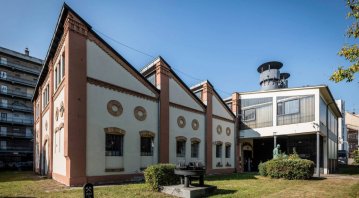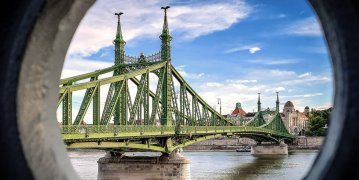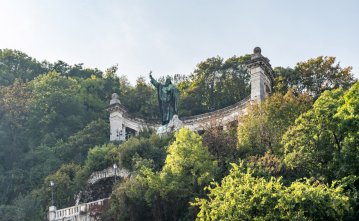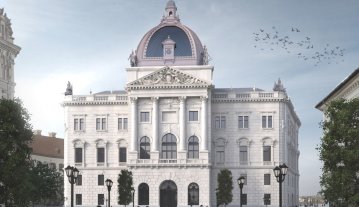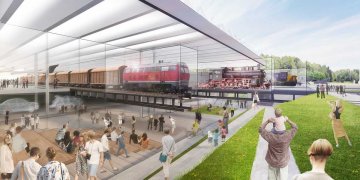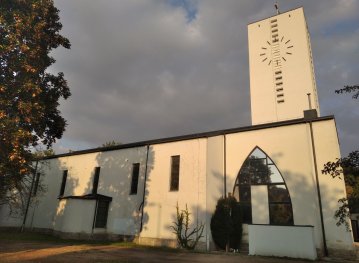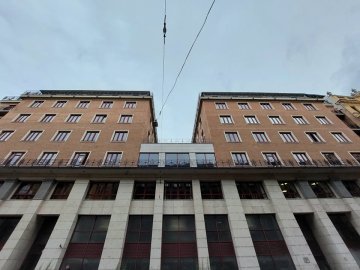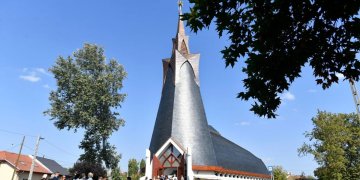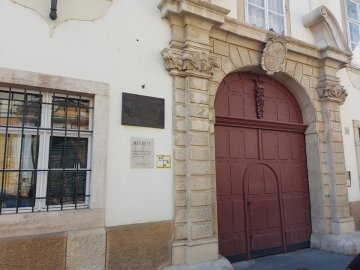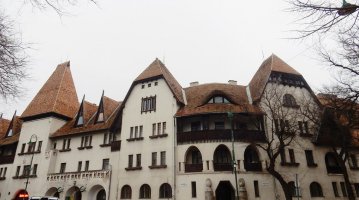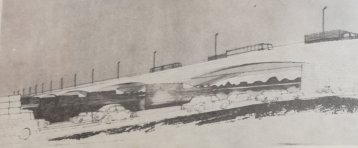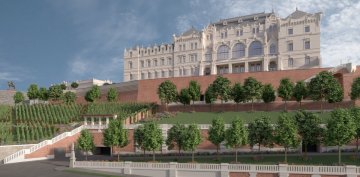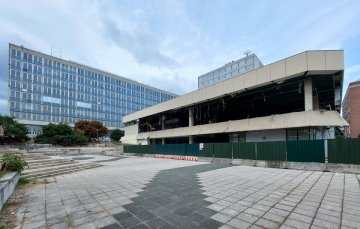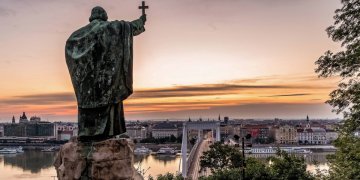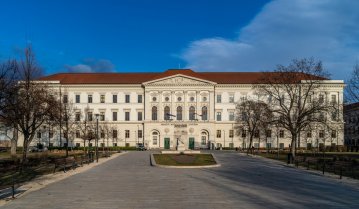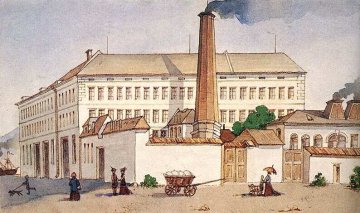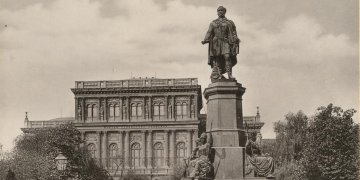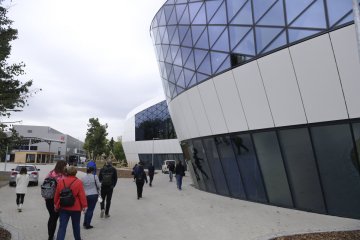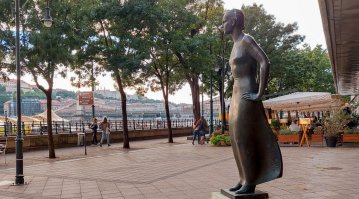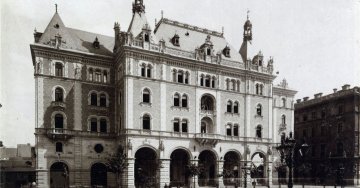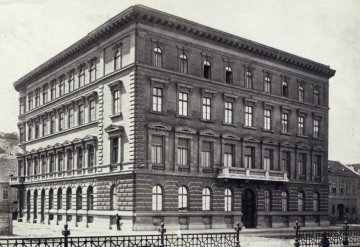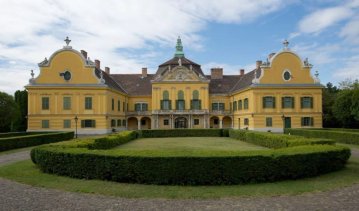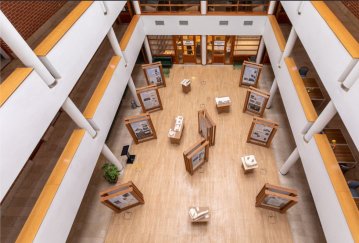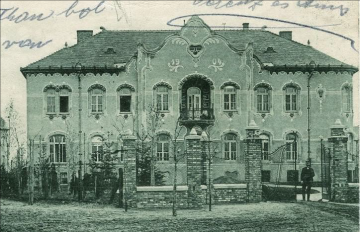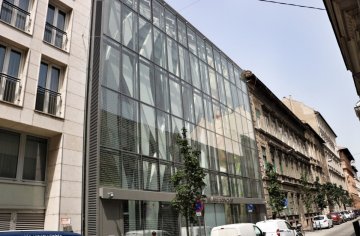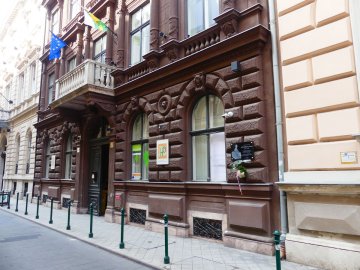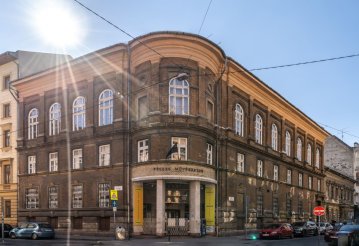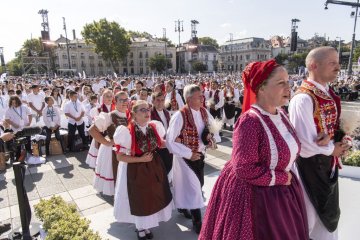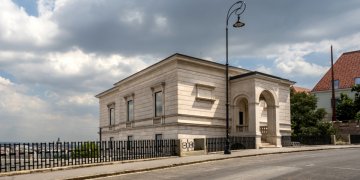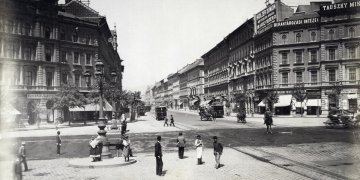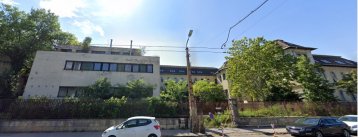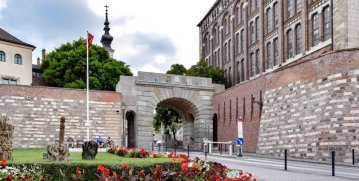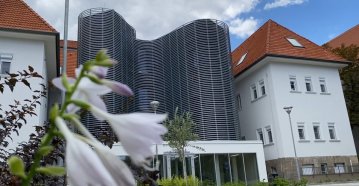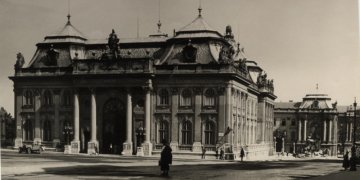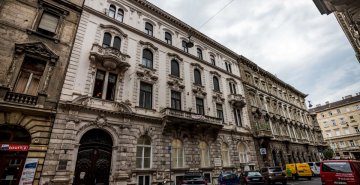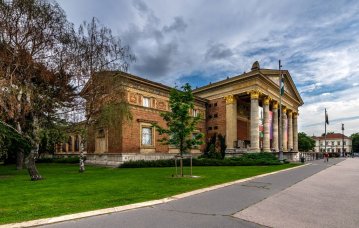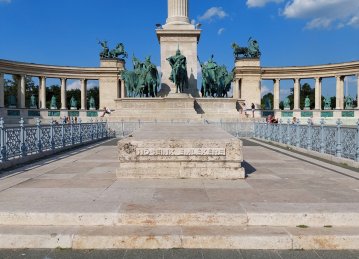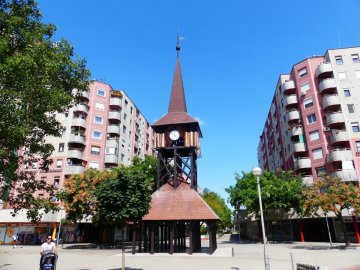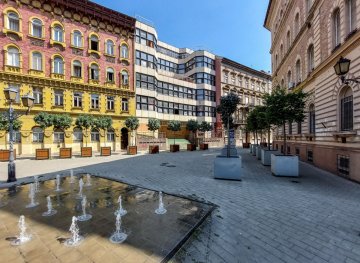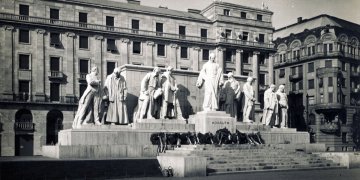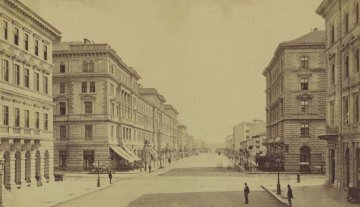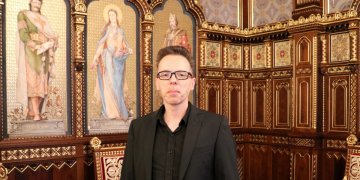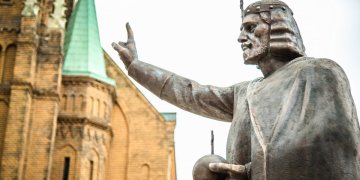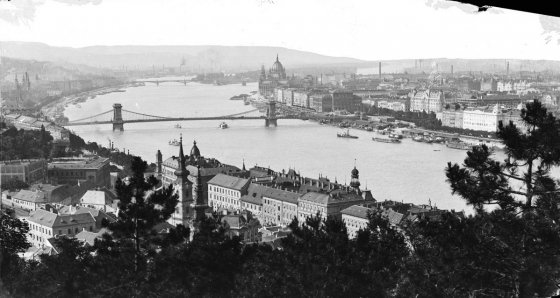 The „intertwined history” of the bridges and the city of Budapest
Which ideas and events have shaped the fate of bridges of Budapest and the cityscape? Alongside many other interesting facts, this question is also answered this newly published book by the Budapest City Archives, which introduces the history of bridges in Budapest.
The „intertwined history” of the bridges and the city of Budapest
Which ideas and events have shaped the fate of bridges of Budapest and the cityscape? Alongside many other interesting facts, this question is also answered this newly published book by the Budapest City Archives, which introduces the history of bridges in Budapest.
Search result
Renovation of the Ganz Ábrahám Foundry Collection building can begin
October 5, 2021 at 4:00 PM
The Ganz Ábrahám Foundry Collection building received the necessary permits for the modernization plans. All the monumental elements of the building will be saved and renovated, there will also be a new conference and event space, and a new, wider exhibition of industrial history will be created. The museum garden will also be open to the public.
Miracle in green: Liberty Bridge, one of the most beautiful ornaments of Budapest, is 125 years old
October 4, 2021 at 9:00 AM
Liberty Bridge is 125 years old. Budapest's shortest Danube bridge hides many interesting things. At the time of its handover, in the year of the millennium, Franz Joseph hammered the last silver rivet in, its colour has been blue and gray in addition to green, they wanted to demolish it once, and at its renovation before the regime change they placed back the historical Hungarian coat of arms cunningly.
Trams from Hanover have been operating in Budapest for 20 years
October 2, 2021 at 4:00 PM
After a long time in the rich tram park of Budapest, the first vehicles manufactured in Western Europe were the trams from Hanover with their characteristic opening staircases, which were put into traffic for the first time on 3 October 2001.
The colonnade of the statue of St. Gellért is being renovated
October 2, 2021 at 12:00 PM
The reconstruction of the column surrounding the statue erected in 1904 will be carried out by the Budapest Gallery, and the works are expected to last until the end of the year. In addition, the Monument to the Displaced and the 56th Memorial Column in Tabán will be renewed.
Reconstruction of the Honvéd High Command building in Buda Castle begins
September 30, 2021 at 4:00 PM
The torso of the Honvéd High Command, originally designed by Mór Kallina, located on Dísz Square, will regain its original form during the reconstruction, and its useful area will more than triple. In the future, it will function as a visitor center, the cultural and tourist gateway of the Buda Castle district.
The investment in the new Transport Museum will be accelerated - Preparatory work may begin next year
September 29, 2021 at 2:00 PM
From 2022, the Northern Vehicle Repair will officially become the home of the Hungarian Museum of Technology and Transport. They are bringing forward the necessary demolition, environmental remediation of contaminated soil and reconstruction of some smaller buildings. Reconstruction of the Diesel Hall into a museum could begin in 2023.
Modern, yet traditionally Hungarian - the Church of St. Michael in Albertfalva is 80 years old
September 29, 2021 at 10:00 AM
September 29 is the feast of St. Michael the Archangel, the most popular, most often depicted angel. He was elected patron of several churches in Budapest, the youngest of which was the parish church of Albertfalva, consecrated in 1941. The modern, yet traditionally Hungarian building has recently been expanded with a new community house.
Simon Tolnai, the Hungarian press magnate built a press empire from scratch in Dohány Street
September 28, 2021 at 9:30 AM
Pestbuda rarely reveals behind-the-scenes secrets of their editorial staff, now they make an exception: when researching the past of Budapest, journalists often look for information or photos in the Tolnai Világlapja newspaper. The first issue of the newspaper was published 120 years ago, on 28 September 1901. Its founder, Simon Tolnai, built his huge press empire from scratch, centred first in the demolished Orczy House on Károly Boulevard and then in Dohány Street. The latter still stands today, operating as an office building.
Makovecz started it, his pupil finished it: The church of Pesterzsébet was inaugurated
September 27, 2021 at 4:00 PM
The Reformed Church of Togetherness in Pesterzsébet-Szabótelep was consecrated, the foundation stone of which was laid on September 23, 2018, and construction began in 2019. A 20th district building is the first church in Budapest, which is based on the ideas of Imre Makovecz. the details of the plans were worked out by Tamás Dósa-Papp, the student of the world-famous architect. The church also has a congregation house and a parish.
Africa researcher, hunter and writer Zsigmond Széchenyi was evicted from the Buda Castle
September 27, 2021 at 9:00 AM
One might think that the life of a world traveller and Africa researcher is enviable. However, this is not necessarily the case with Zsigmond Széchenyi: one of the most significant Hungarian travellers and hunters of the 20th century was dragged and evicted from the Buda Castle by the communist regime. As part of the ‘One with Nature’ World of Hunting and Nature Exhibition, an exhibition of his photographs taken during the expeditions will open at the Capa Centre in Budapest.
Wekerletelep in Kispest also preserves the memory of the prime minister who passed away a hundred years ago
September 26, 2021 at 9:30 AM
Wekerletelep with its special atmosphere is located in Kispest. Its smaller and larger houses form this fairytale-looking part of the city in a uniform style, arranged in streets that are inexplicable for an outsider, but are in a regular order. Its creation was initiated by Sándor Wekerle, one of the most prominent Hungarian prime ministers, who passed away a hundred years ago.
Fifty years ago, a highway bridge was designed on the edge of the inner city
September 25, 2021 at 10:00 AM
Increasing car traffic has been a problem in the capital for decades. It even come up in the early 1970s that a a huge highway bridge should be built on the Danube in the Lágymányos area. If that planned bridge had been realized, we would be living in a different Budapest today.
The foundation of the Archduke's Palace in Buda Castle is already under construction
September 24, 2021 at 4:00 PM
Work on the foundations of the former palace of Archduke Joseph began in Buda Castle, Szent György Square. The building will be rebuilt according to the original plans under the National Hauszmann Program.
The first step in the construction of the BME Innovation and Development Center - The canteen of Goldmann Square will be demolished
September 24, 2021 at 2:00 PM
The demolition of the Goldmann Canteen building on Goldmann György Square near the Buda end of the Petőfi Bridge has begun. The former university restaurant and the adjoining building called BME V2, formerly home to the Faculty of Electrical Engineering of the Technical University, will be replaced by the BME Innovation and Development Center.
From whom Gellért Hill was named: the educator of prince Emeric died a martyr's death 975 years ago
September 24, 2021 at 9:03 AM
The name and legend of Saint Gellért is known not only to the Hungarians, but certainly to the tourists visiting here. If for no other reason, because the Gellért Hill statue of the first martyr of Christian Hungary is an integral part of the Budapest cityscape; the bishop has been holding the cross high above the capital for more than a hundred and ten years. The memory of Bishop Gellért, who died a martyr's death in 975 years, is preserved not only on the mountain, but also in many other works in the capital.
The Regnum Marianum church was blown up seventy years ago
September 23, 2021 at 3:00 PM
The Regnum Marianum church stood on the edge of Városliget for only twenty years. The church, consecrated in 1931, was blown up on September 23, 1951. The leaders of the communist dictatorship invoked town planning reasons, but in reality they wanted to demolish the church, which was built out of “gratitude” for Hungary gettingt rid of the arbitrariness of the Soviet Republic.
Renovation of Ludovika continues - We have the designers
September 22, 2021 at 2:30 PM
Renovation of two more parts of the building may begin in the near future on the Ludovika Campus of the University of Public Service. Based on the recently completed public procurement procedure, the planning of the reconstruction of the so-called Tóparti building in the Diószegi Street section and the planning of the renovation of the Ludovika Fencing Hall and Event Center on Üllői Street will begin.
The first steam mill in Pest started significant industrial development - the József Rolling Mill started operating 180 years ago
September 22, 2021 at 9:00 AM
Today it is difficult to imagine, but once the first steam mill in Pest was built and operated in Lipótváros, in the area bordered by today's Bálint Balassi - Béla Stollár - Falk Miksa and Balaton Streets, which started operating on 22 September 1841. However, the József Hengermalom [Rolling Mill] was more than a simple mill. The modern plant established on the initiative of István Széchenyi was not financially successful, but as a result the milling industry and the machine industry also started to develop significantly. Pest in the second half of the 19th century became a major power of the milling industry.
Stations of a Life - The memory of István Széchenyi, born 230 years ago, in the square named after him
September 21, 2021 at 9:00 AM
The year 2021 can also be called the Széchenyi Year, as Hungarians celebrate the 230th anniversary of the count's birth on 21 September. In addition, there is a square in Pest that had been named after the biggest Hungarian for 10 years, and most of its corners are related to a certain stage of the count's life or patriotic deeds. It is the square at the Pest end of the Chain Bridge, which István Széchenyi may have known as Kirakodó Square.
The new Hungexpo lures everyone in
September 20, 2021 at 7:30 PM
One of the largest and most modern congress and conference centres in Central Europe has been established in Budapest, on the territory of Hungexpo. The existing buildings have been renovated and completely new ones have been built, which impress the visitors not only with their equipment but also with their appearance.
Across Budapest we can see the statues of Pál Pátzay, born 125 years ago
September 20, 2021 at 9:00 AM
The round anniversary provides an opportunity to take an objective approach to the artist, who was imprisoned after the Hungarian Soviet Republic and then joined the Roman school in the 1930s and became more widely known through his sculptures of party leaders in the decades of socialism. His sculptures can be found in several places all over the city: with Bálint Balassi on the Kodály Körönd, with the female figure defying the wind on the Danube Promenade, or with the Raoul Wallenberg monument in St. Stephen's Park.
World-famous architects in Budapest
September 19, 2021 at 9:30 AM
In 1930, Budapest hosted the 12th International Congress of Architects, which was attended by architects from all over the world. As an accompanying event to the triennial event, a large-scale architectural design exhibition was held in Budapest, which was open to the public between the 6th and 16th of September 1930.
Forest of Keresztúr: the living history of Budapest
September 18, 2021 at 9:00 AM
The largest contiguous forest in Pest would have long been worth an article on the list of natural sights of Budapest. Like so many other places in the capital, it has been a time of renovation and tidying up here in recent years: the Forest of Keresztúr can provide recreation or arouse interest for many people today. In this article, Pestbuda explores this somewhat forgotten but great natural attraction.
The other Andrássy Palace - After the war, the Bem quay building was demolished
September 17, 2021 at 11:00 AM
The son of Prime Minister Gyula Andrássy once lived with his family in the three-storey palace on the banks of the Danube. in which we can see today the modern building of the French Institute. The elegant Neo-Renaissance building on the Bem Quay was demolished after World War II and was replaced by an empty plot for decades.
The Rider's Garden and the Tickler's Courtyard in Buda Castle are finished
September 15, 2021 at 9:00 AM
From this weekend, anyone can see the rebuilt Buda Castle Riding School, the Chico Courtyard and the Stöckl Staircase. During the authentic reconstruction, the original turn-of-the-century plans by Alajos Hauszmann were faithfully followed, but the inside of the Riding Hall was equipped with the most modern technical solutions.
Ferenc Ripka, born 150 years ago, was mayor of Budapest but his name is hardly known
September 14, 2021 at 9:00 AM
The name of Ferenc Ripka has been hardly known, although for eight years, between 1924 and 1932, he was the head of Budapest. As one of the most influential mayors of the period between the two world wars, he did much to improve the public health system of the capital. Today, his memory is preserved by a street in Óbuda and a plaque in his former residence, Gellérthegy Street.
András Mayerhoffer, the creator of the Hungarian Baroque style, died 250 years ago
September 12, 2021 at 9:30 AM
András Mayerhoffer, born in Salzburg, is one of the leading figures of Baroque-Rococo architecture in Hungary. He is also known as the creator of the so-called Grassalkovich or Gödöllő style. The works of the master builder and architect, who died 250 years ago, such as the first two-towered Catholic Church in Pest or the former Péterffy Palace in Piarista Street - are still defining elements of Budapest's cityscape.
A clock with a Hebrew dial has been installed in the synagogue of Óbuda
September 11, 2021 at 5:30 PM
The Old Buda Synagogue is celebrating its 200th anniversary this year, and has now regained its former façade decoration, the clock with the Hebrew dial.
The Győző Czigler exhibition is still open at the Archives of Budapest
September 10, 2021 at 4:00 PM
The exhibition of Győző Czigler's architecture is open until the end of October. The Archives of the Budapest Capital's and the Hungarian Architectural Museum and Monument Documentation Centre's jointly organised exhibition presents the career of the much-used architect of Hungarian historicism with the help of tables and models.
Monument research on the Art Nouveau hospital building
September 10, 2021 at 9:30 AM
Most of the people living in the area still mention the North Pest Hospital as a former Russian hospital, whose buildings are located in Pestújhely, on a landscaped area of more than 7 hectares. The institution was originally built as a mental hospital in the Art Nouveau style. The plans for the renovation of the institution and the monument research were recently carried out by the owner, the 15th District Local Council.
New swimming pool opened in the city centre
September 8, 2021 at 2:30 PM
Built at 30 Vadász Street after a summer trial run, the V.30 Sports Centre, can be visited and tried out by anyone, not just by residents of the V district, from September. The facility, built with ecological and energy efficiency in mind, has a 25-metre swimming pool, a teaching pool and a spa with thermal water.
A memorial plaque was erected on the former residence of Julia Szendrey
September 7, 2021 at 5:30 PM
In the last months of her life, she lived at 13 Horánszky Street, formerly Zerge Street, in Józsefváros. Júlia Szendrey, poet, writer and translator, Petőfi's wife and muse. His memory is now commemorated by a plaque on the façade of a house in the Palace Quarter.
The famous Fészek Klub opened 120 years ago
September 7, 2021 at 9:00 AM
The Festők, Építészek, Szobrászok, Zenészek, Énekesek és Komédiások Klubja [Painters, Architects, Sculptors, Musicians, Singers and Comedians Club] or the Fészek Klub opened 120 years ago, on 7 September 1901, on the corner of Kertész Street and Dob Street. The legendary club has been a popular and beloved meeting place for the arts scene for decades, but is now more of an events venue. Just like the club scene of the old days, the original elegant Art Nouveau building and its lavish décor are a thing of the past.
The world is watching Budapest - The Eucharistic Congress has begun
September 6, 2021 at 9:00 AM
Budapest hosts the International Eucharistic Congress for the second time. In addition to the main venues - Heroes' Square, Hungexpo, St. Stephen's Basilica, Kossuth Square, Academy of Music - there will be programmes, concerts and stage performances in several parts of the city.
The renovated Lónyay-Hatvany villa on the Buda Várhegy was inaugurated
September 5, 2021 at 10:00 AM
The villa, originally designed by Miklós Ybl and built in 1872, was bombed, burnt down and demolished during the Second World War. It was completely rebuilt after the turn of the millennium, but has stood empty for the last few years. Recently renovated for the Lajos Batthyány Foundation, the building will serve as the future headquarters of the organisation.
The Outer Ring Road was inaugurated 125 years ago - Budapest's main road was opened on Hungary's millennium
September 4, 2021 at 10:00 AM
Today, Outer Ring Road is one of the busiest roads in Budapest, lined with beautiful residential houses. Its construction lasted for 25 years, to open it, houses had to be demolished, a railway station had to be moved away, an area had to be filled, but finally, 125 years ago, on 31 August 1896, the Budapest Public Works Council could officially hand it over to the Budapest community.
Tender for the design of the Hungarian Museum of Architecture
September 3, 2021 at 3:00 PM
On the site of the former BM-hospital at the corner of Bajza street and Városligeti fasor, the Hungarian Museum of Architecture and Documentation Centre for Historic Monuments is being formed. After demolition work was completed in the summer, the site is now reduced to two historicised sanatorium buildings. The planned building will be smaller than the demolished houses, leaving a large green area on the site.
The newest Vienna Gate is eighty-five years old
September 2, 2021 at 9:00 AM
Eighty-five years ago, in 1936 the Vienna Gate of the Buda Castle was rebuilt. The plan had already been conceived six years earlier, but because of the economic crisis the financial backing could only be secured for that time. The occasion for the construction was the two hundred and fiftieth anniversary of the recapture of Buda, which was on 2 September 1686.
New towers on Amerikai Road - The main building of the Mazsihisz Charity Hospital was renovated
September 1, 2021 at 10:00 AM
The new main building of the Mazsihisz Charity Hospital [Szeretetkórház] in Budapest on Amerikai Road was renovated. It was originally built in 1914 and returned to the community in 1994 from the Uzsoki Street Hospital. The renovated 2300 square metre building also got distinctive towers.
Budapest then and now – 6 photos showing how much the cityscape has changed over a century
August 31, 2021 at 9:00 AM
The change in Budapest can be surprising when looking at old pictures: the former riding hall behind the National Museum, the New Building (Újépület) on the site of the current Szabadság Square, the disappeared houses of Pest and Buda downtown, the former splendour of the Buda Palace, and the beautiful historic buildings which stood on the site of the series of hotels along the Danube. What has changed and what is constant? Take a look at the six pictures Pestbuda collected.
The Ikarus 66 was an iconic piece of Hungarian bus production – Now we can see it renovated in the Museum of Transport
August 28, 2021 at 12:00 PM
A special bus was presented to the general public yesterday by the Museum of Transport: one of the last ten Ikarus 66 models produced. The vehicle was exhibited after several years of restoration in Kőbánya, in the Diesel Hall of the former Northern Locomotive Workshop. Budapest once expected these Ikarus buses to make transportation faster and more convenient, but passengers in the capital found them uncomfortable.
Where Mór Jókai and Johann Strauss Jr. met - A fire destroyed the German Theatre in Lipótváros
August 27, 2021 at 12:30 PM
At 24 Báthory Street, 5th District, it can be found out only from a memorial plaque that the German Theatre of Pest once stood here. This was already the third venue for German acting in Pest, but the theatre could not function here for a long time either. Twenty years after its opening, on 20 December 1889, a fire destroyed the building, in which Mór Jókai also turned, and an operetta written from his work was even performed here.
Preparations for the renovation of the Kunsthalle have begun
August 26, 2021 at 2:00 PM
The building of the Kunsthalle in Heroes' Square was built for the Millennium Exhibition according to the plans of architect Albert Schickedanz. On the 125th anniversary of its existence, preparations began for the complete renovation of the building.
The Memorial Stone of Heroes was torn down 70 years ago
August 26, 2021 at 11:00 AM
In the shadow of the Millennium Monument, another work is hidden in the Heroes' Square. The Memorial Stone of Heroes symbolises a mass grave, originally erected in 1929, in memory of the soldiers of the First World War resting in anonymous graves, but it was not mourning that was its primary message, but mobilisation against the changing millennial boundaries. The memorial stone was demolished in 1951 but re-erected in the spring of 1956 and then in 2001, in a different form and with new messages.
The clock tower in Káposztásmegyer was renovated
August 24, 2021 at 3:00 PM
A nice and interesting highlight of the microdistrict in Káposztásmegyer is the clock tower reminiscent of the Transylvanian belfries. The building, made of oak by handicrafts, was renovated and cleaned in August.
The tumultuous fate of the small Pompidou in Pest - The former building of the Almássy Square Leisure Center is transformed into a hotel
August 24, 2021 at 9:00 AM
The Almássy Square Leisure Center has been sleeping its (second) Sleeping Beauty dream for almost a decade. The former popular cultural institution was sold by the municipality of Erzsébetváros in 2007 and although the hotel building plans at the time did not materialize, an application for a building permit was recently submitted to expand and transform the building, 35 years ago known as the small Pompidou in Pest, to a hotel.
The migration of the Kossuth statue in front of the Parliament - They wanted to erect the monumental memorial opposite the main entrance of the Parliament
August 22, 2021 at 11:00 AM
The square in front of the Parliament has been called Kossuth Square since 1927, since the statue of the great statesman was inaugurated that year. The designation of its exact location provoked lengthy debates, and the finished work was tentatively erected at several points of the square by the time it reached its final location.
Inspired by the boulevards of Paris - in 1876 the present-day Andrássy Avenue was handed over
August 21, 2021 at 10:00 AM
The traffic between the inner city of Pest and the Városliget went through Király Street for a very long time. The narrow street was very crowded, as not only the normal traffic passed through here, but also those who wanted to go to the Városliget for a little refreshment. The Avenue [Sugárút in Hungarian], officially handed over 145 years ago, in 1876, today's Andrássy Avenue, along which lavish palaces were built in place of the one-storey houses, was made to aid this situation.
"The architects of the Royal Palace were geniuses" says the re-designer of St. Stephen's Hall
August 20, 2021 at 10:00 AM
As an architect, he redrawn every detail of the St. Stephen's Hall, which opens on 20 August: the windows, historic doors, and parquet floors of the southern connecting wing of the Royal Palace. Tibor Angyal has been recreating the historic ceremonial hall destroyed after World War II for six years and, with experience, he claims that the reconstruction of the Royal Palace, which was destroyed with mad rage and method after the war so that not a single square metre of original space remains, is a historic opportunity.
There was no place for it in the St. Stephen's Park - the statue of our founding king was erected in Kispest
August 19, 2021 at 6:30 PM
The work was originally intended to replace the statue of György Lukács in Szent István Park, but the Capital decided otherwise, so the 2.5-metre-high bronze statue of our founding king ended up not in the park named after him, but in the Templom Square of the 19th District.
 The „intertwined history” of the bridges and the city of Budapest
Which ideas and events have shaped the fate of bridges of Budapest and the cityscape? Alongside many other interesting facts, this question is also answered this newly published book by the Budapest City Archives, which introduces the history of bridges in Budapest.
The „intertwined history” of the bridges and the city of Budapest
Which ideas and events have shaped the fate of bridges of Budapest and the cityscape? Alongside many other interesting facts, this question is also answered this newly published book by the Budapest City Archives, which introduces the history of bridges in Budapest.
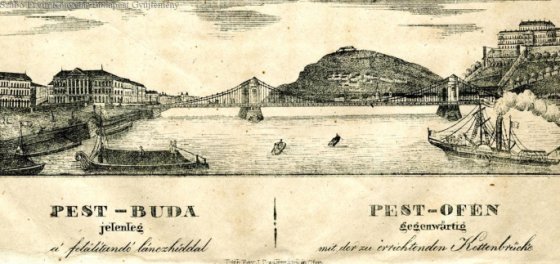 The Bridge Report, which brought a turning point in the history of Budapest
A travel report that changed the history of Pest and Buda, as well as Hungary. The little book contributed to the change of half a thousand years of legal customs and the implementation of an investment of unprecedented size and technical quality. This book was The Bridge Report [Hídjelentés in Hungarian].
The Bridge Report, which brought a turning point in the history of Budapest
A travel report that changed the history of Pest and Buda, as well as Hungary. The little book contributed to the change of half a thousand years of legal customs and the implementation of an investment of unprecedented size and technical quality. This book was The Bridge Report [Hídjelentés in Hungarian].
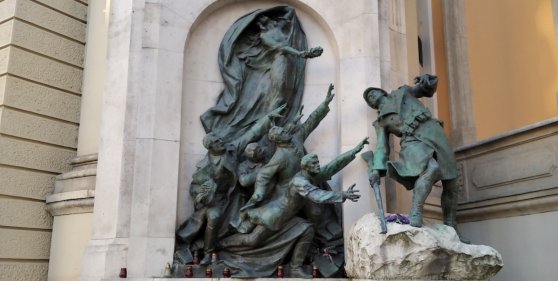 Drama on the university wall - The heroic monument was planned 95 years ago
In the constant hustle and bustle of the Egyetem Square in Pest, the students may not even notice the monument that decorates the short section of wall between the church and the central building of ELTE. However, it commemorates their predecessors, the heroes who fought for their country in World War I, and those who heroically helped them. The first design of the dramatically collapsing soldier was born in 1928, ninety-five years ago.
Drama on the university wall - The heroic monument was planned 95 years ago
In the constant hustle and bustle of the Egyetem Square in Pest, the students may not even notice the monument that decorates the short section of wall between the church and the central building of ELTE. However, it commemorates their predecessors, the heroes who fought for their country in World War I, and those who heroically helped them. The first design of the dramatically collapsing soldier was born in 1928, ninety-five years ago.

